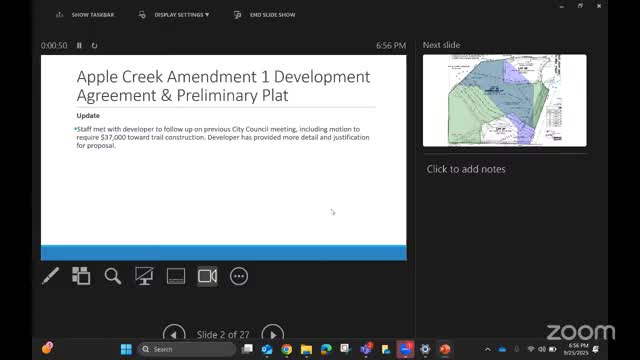City Council Reviews Church Meeting House Site Plan and Parking Requirements
September 26, 2025 | Nibley , Cache County, Utah
This article was created by AI summarizing key points discussed. AI makes mistakes, so for full details and context, please refer to the video of the full meeting. Please report any errors so we can fix them. Report an error »

In the heart of Nibley City, the council convened on September 25, 2025, to deliberate on a significant development proposal that promises to reshape the community's landscape. The atmosphere in the council chamber was charged with anticipation as members discussed the implications of a new subdivision that aims to enhance conservation efforts while providing additional recreational space for residents.
At the forefront of the discussion was a motion to approve a development plan that includes the dedication of approximately two-thirds of an acre as conservation space. This proposal, presented by developer Clay Shacker, seeks to clarify the benefits that the subdivision would bring to the city, emphasizing the importance of clearly delineated conservation areas. Shacker explained that the new plan would replace a less defined conservation easement with a more structured approach, ensuring that the land remains protected from future development.
The council members listened intently as Shacker outlined the financial implications of the proposal, estimating a net benefit of around $207,000 for the city. This figure includes the value of the newly designated conservation land and the transfer of trail rights to the city, which would enhance public access to the area. Shacker highlighted that the previous easement, which he currently owns, posed risks of being neglected if ownership changed hands. By transferring these rights to the city, he argued, the community would gain a more reliable and accessible trail system.
As the discussion unfolded, council members raised questions about the practicalities of the proposal, including maintenance plans for the conservation area and the potential for future development in adjacent subdivisions. The conversation also touched on the importance of ensuring that the trail system is accessible and well-integrated into the community, with considerations for wheelchair access and safety.
The council ultimately faced a decision on whether to approve the development with the proposed conditions, including a $37,000 fee for the trail right-of-way. While some members expressed concerns about the financial implications, others recognized the long-term benefits of preserving open space and enhancing recreational opportunities for residents.
As the meeting drew to a close, the council's deliberations underscored a broader commitment to balancing development with conservation. The outcome of this proposal could set a precedent for future projects in Nibley City, reflecting a growing awareness of the need to protect natural spaces while accommodating community growth. The council's decision will not only impact the immediate area but also shape the city's vision for sustainable development in the years to come.
At the forefront of the discussion was a motion to approve a development plan that includes the dedication of approximately two-thirds of an acre as conservation space. This proposal, presented by developer Clay Shacker, seeks to clarify the benefits that the subdivision would bring to the city, emphasizing the importance of clearly delineated conservation areas. Shacker explained that the new plan would replace a less defined conservation easement with a more structured approach, ensuring that the land remains protected from future development.
The council members listened intently as Shacker outlined the financial implications of the proposal, estimating a net benefit of around $207,000 for the city. This figure includes the value of the newly designated conservation land and the transfer of trail rights to the city, which would enhance public access to the area. Shacker highlighted that the previous easement, which he currently owns, posed risks of being neglected if ownership changed hands. By transferring these rights to the city, he argued, the community would gain a more reliable and accessible trail system.
As the discussion unfolded, council members raised questions about the practicalities of the proposal, including maintenance plans for the conservation area and the potential for future development in adjacent subdivisions. The conversation also touched on the importance of ensuring that the trail system is accessible and well-integrated into the community, with considerations for wheelchair access and safety.
The council ultimately faced a decision on whether to approve the development with the proposed conditions, including a $37,000 fee for the trail right-of-way. While some members expressed concerns about the financial implications, others recognized the long-term benefits of preserving open space and enhancing recreational opportunities for residents.
As the meeting drew to a close, the council's deliberations underscored a broader commitment to balancing development with conservation. The outcome of this proposal could set a precedent for future projects in Nibley City, reflecting a growing awareness of the need to protect natural spaces while accommodating community growth. The council's decision will not only impact the immediate area but also shape the city's vision for sustainable development in the years to come.
View full meeting
This article is based on a recent meeting—watch the full video and explore the complete transcript for deeper insights into the discussion.
View full meeting

